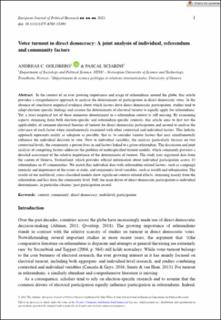| dc.description.abstract | In the context of an ever growing importance and usage of referendums around the globe, this article provides a comprehensive approach to analyse the determinants of participation in direct democratic votes. In the absence of conclusive empirical evidence about which factors drive direct democratic participation, studies tend to adopt election-specific findings and assume the determinants of electoral turnout to equally apply for referendums. Yet, a strict empirical test of these numerous determinants in a referendum context is still missing. By examining aspects stemming from both election-specific and referendum-specific contexts, this article aims to first test the applicability of common electoral theories of turnout for direct democratic participation and second to analyse the relevance of each factor when simultaneously examined with other contextual and individual factors. This holistic approach represents reality as adequate as possible, that is, to consider various factors that may simultaneously influence the individual decision to vote. Next to individual variables, the analysis particularly focuses on two contextual levels, the community a person lives in and factors linked to a given referendum. The discussion and joint analysis of competing factors addresses the problem of underspecified turnout models, which commonly prevents a detailed assessment of the relative importance of the determinants of turnout. The study uses registered data from the canton of Geneva, Switzerland, which provides official information about individual participation across 43 referendums in 45 communities. We match this individual data with referendum-related factors, such as campaign intensity and importance of the issues at stake, and community-level variables, such as wealth and urbanization. The results of our multilevel, cross-classified models show significant context-related effects, stemming mainly from the referendum and less from the community level. Still, the main driver of direct democratic participation is individual determinants, in particular citizens' past participation record. | en_US |

